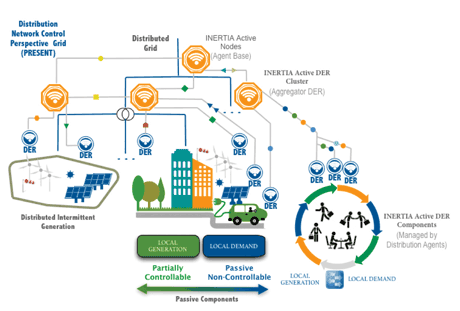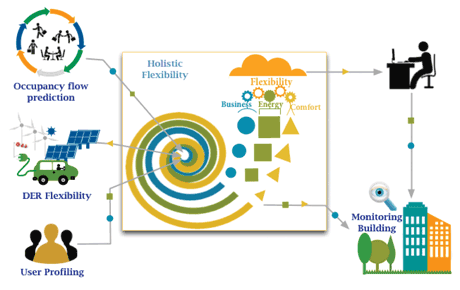by Giampaolo Fiorentino and Antonello Corsi
A new overlay network which runs on top of the electricity grid, puts together old and new renewable energy sources, giving life to the Internet of Energy. A coordinated and controlled Internet of Things will optimize the Distribution Grid Control and the Demand Side Management (DSM) based on business, comfort and occupancy dynamic, introducing the autonomous intelligent Commercial Prosumer Hub.
The introduction of new kinds of energy mixes to the electricity grid is a challenging environmental task for present and future generations as they fight the pollution and global warming issues associated with urbanization. Individual appliances and whole buildings that continuously incorporate local intelligence which originates from the new technologies of Internet Of Things (IoT) are the new infrastructure that this integration will be based on. Smart Electricity Grids are becoming more intensively integrated with tertiary building energy management systems and distributed energy generators such as wind and solar. Optimal energy management strategies require the ability to control and predict energy consumption incorporating all types of DER (distributed energy resources), at both local and global scales.
The INERTIA project
In the context of the EU FP7- ICT project INERTIA, a consortium of 10 complementary partners from six different European Countries aims at addressing the important challenges that future energy systems will face by building a new modelling methodology that integrates physical components and cyber technologies, thus creating Cyber Physical Energy Systems. The INERTIA project works on the definition of a new data management infrastructure to allow electricity production and consumption to be measured, reported and controlled, delivering an efficient Distribution Grid overlay control/management infrastructure (Figure 1). This new infrastructure will maximize the response capacity of the vast, small-commercial prosumer base (e.g., tertiary buildings, offices, etc.), presenting incentives and delivering benefits through their automated active participation in the energy market.

INERTIA extends the DSM strategies by incorporating various types of DER going beyond simple consumer loads, and treats both local generation and consumption under a single unified framework. The concept of DER flexibility will also be extended to incorporate various local context parameters, which affect DER operation and performance, as well as potential capacity of DER to provide flexible services to the Distribution Grid. This model includes the impact of communication networks and further, cyber components as well as the relevant information of the physical system.
The INERTIA framework
The old approach [1, 2] was to try to align consumption by asking consumers to reduce their power usage rather than increasing the power generation facilities. Under this approach, consumers that cooperated might receive incentive payments from the power company. In comparison, the INERTIA project claims to solve this issue using IoT technologies to expand DR services based on the analysis of users’ historical interactions with the lighting, HVAC and other appliances controls. This has been realized calculating energy consumption, flexibility and forecast demand using a holistic flexibility model, which calculates several key performance indicators which can be categorized in Business, Energy, Comfort and Flexibility. Furthermore, real-time employee activities including arrival and departure times and meetings attendance (Figure 2) are also simulated.

Besides, INERTIA takes into account how demand response can change the end user comfort using a Bayesian formalism. This formalism is applied to infer the probability that any environmental situation should be considered by the user as environmentally uncomfortable, defining the upper and lower limits of the energy flexibility that can be offered to the whole energy system.
So, the holistic flexibility model is able to safeguard the electricity grid, facing a trade-off between energy provided by the local generation facility and consumers’ consumption. In this respect, the holistic flexibility model generates the suitable energy demand strategy deploying DSM operations, which takes into account the final users comfort. The comfort is evaluated also by the facility manager selected to enroll a specific DR program
Conclusion
New IoT technologies are essential for implementing electrical power systems in Smart Cities and reducing environmental impacts and social costs. At the moment, appliances can self-adjust to consume less power or even turn themselves off. Using the data collected from all the devices, algorithms can calculate the exact energy demand so to reduce the need for standby generation. Over time, generation can be automatically shifted according to predicted increases and decreases in demand. Morover, a framework that receives input from relevant sources such as weather information, heating, cooling, lighting equipment and usage scenarios (occupancy rates) can be implemented to compute energy consumption and identify available flexibilities from DER. This could be conducted in a non-invasive way that would respect the comfort of the end user.
Acknowledgments
This work was partially supported by the EU project “INERTIA - Integrating Active, Flexible and Responsive Tertiary Prosumers into a Smart Distribution Grid” (FP7-ICT-2011-8, Grant Agreement No. 318216).
Link: http://www.inertia-project.eu/
References:
[1] A Di Giorgio, L Pimpinella: “An event driven Smart Home Controller enabling consumer economic saving and automated Demand Side Management”
[2] P Palensky, D Dietrich: - Industrial Informatics, IEEE …, 2011 - Demand side management: Demand response, intelligent energy systems, and smart loads
Please contact:
Giampaolo Fiorentino, Antonello Corsi
R&D Lab - Engineering Ingegneria Informatica S.p.A, Italy
E-mail: {giampaolo.fiorentino, antonello.corsi}@eng.it











